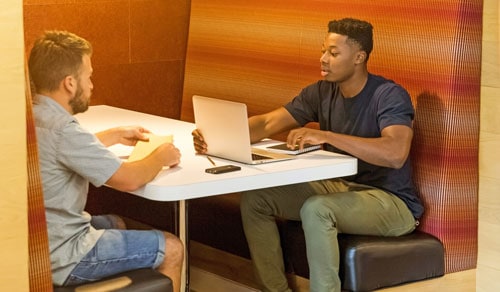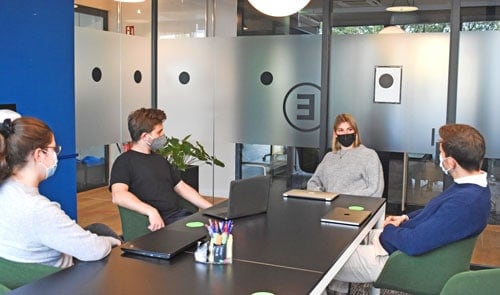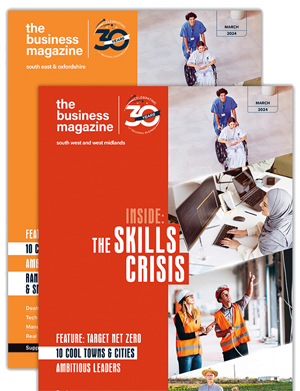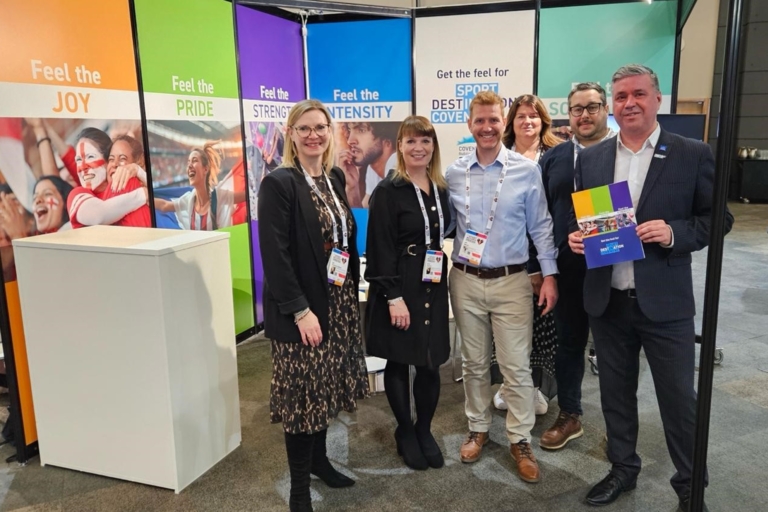Brave new world of work

 Businesses have had to be agile over the past year, adapting their management policies and work practices to respond to unprecedented market conditions. In such a dynamic environment, how have they kept their employees safe, healthy and engaged? Nick Warburton reports.
Businesses have had to be agile over the past year, adapting their management policies and work practices to respond to unprecedented market conditions. In such a dynamic environment, how have they kept their employees safe, healthy and engaged? Nick Warburton reports.
Employers have both a legal requirement and a moral responsibility to safeguard employee health and safety, but taking a preventative approach to occupational injury and illness also makes sound business sense.
The Health and Safety Executive (HSE) estimates that around 38.8 million working days were lost due to work-related ill health and non-fatal workplace injuries in Great Britain in 2019/2020, with stress, depression or anxiety and musculoskeletal disorders accounting for most.
The cost of this ill-health burden on the UK economy was more than £16 billion over this same period.
The past year in particular has been one of unprecedented change. The pandemic has caused significant disruption to traditional work practices and for most businesses engineered a seismic and sudden shift to remote working.
Although many had operated flexible work practices pre-pandemic, the spike in home-based telework has presented a challenge for some employees whose homes are ill-equipped to serve as office spaces.
Many have also found themselves putting in more hours as the lines have blurred between the home and work environment.
The pandemic has also created new psychosocial risks. Many workers have lost that physical, social interaction they had with colleagues and may be struggling to remain connected with their organisation and colleagues as they juggle care responsibilities with competing deadlines.
To their credit, some businesses have moved at speed to establish Covid-secure workspaces, enabling business-critical staff and others to return to the office while also able to work at home several days a week.
Business continuity: adaptability counts
Companies like PwC and KPMG had invested heavily in technology pre-pandemic, so the move to remote working was seamless and has operated well.
Julian Gray, market senior partner for PwC, said that when the first lockdown was announced it switched all 22,000 of its UK employees to home working overnight, with no impact on business operations.
“The only question hanging over us was ‘would everything stand up with 22,000 staff doing it all at the same time?’. The simple answer was yes, we were able to do that without a detriment to the level of service and support to our clients.”
Will Smith, senior partner for KPMG in the South East, reports a similar experience and adds that the flexibility of being able to work remotely has been positively received.
“Our latest insights revealed that the vast majority of our people are comfortable with home working, citing reduced commutes, greater flexibility of working hours and a better work-life balance as being among the positives,” he said.
However, research carried out by multinational technology company Microsoft among its international staff suggests that the high productivity seen during the pandemic’s first year masks an exhausted workforce.
Should this be the case more generally, it emphasises the need for targeted wellbeing support, especially around resilience, mental health, mindfulness and self-care.
Health insurance agency Westfield Health recently published its Coping after Covid report, which looked at the pandemic’s impact on morale, wellbeing and productivity.
Its headline message was that businesses needed to maximise their investment in wellbeing interventions, adding that the increased productivity that would result from this spend could add £61b to the English economy by 2025.

Increased interest in introducing EAPs
Everyone interviewed for this article agreed that there is no one-size-fits all approach to safeguarding employee wellbeing. Rather, it is about accommodating each individual’s unique circumstances and making allowances for different needs.
The HSE emphasises the importance of stress management and resilience and advises employers to provide staff with access to Employee Assistance Schemes (EAPs).
According to Steph Barnett, managing director of Pure Human Resources, the HR consultancy’s clients have shown an increased interest in introducing EAPs as another means of supporting their team. For her staff, respecting individuals’ feelings about the pandemic has been critical.
“Some people have struggled with isolation, some thrive on the quiet that it brings, but most seem to oscillate between the two,” she confides.
When the first lockdown happened, KPMG took prompt action, including the introduction of a buddying scheme to help employees remain connected with colleagues.
David Thomas, occupier advisory partner at Reading-based property consultants Vail Williams LLP, said the business has regular check-ins to pick up on any staffing concerns. The business won an Investors in People gold award last year and has rolled-out a suite of measures, including training mental health first aiders.
But psychosocial issues such as depression, anxiety and loneliness are only part of the picture.
‘The business has also set up confidential support lines offering 24/7 assistance for those struggling with mental health issues, as well as specialist support for employees who are victims of domestic violence’
As the HSE’s latest research reveals, musculoskeletal disorders are one of the leading causes of workplace ill health. Under the Health and Safety at Work Act 1974, employers are required to carry out risk assessments on all work activities carried out by employees, including homeworkers.
Assessing the risks and needs of home working
Although the pandemic makes it impracticable for employers to carry out a full risk assessment in the home environment, employers must ensure that work stations are set up correctly and provide suitable office equipment, together with guidance, to minimise the risk of musculoskeletal issues developing.
Adrian Powell, director for Active Work Solutions, a workspace specialist, said that one of the benefits of being a small business is that it has been able to help its employees undertake self-assessments over a Zoom call. The business, which fits out offices for SME clients through to large blue-chip companies, has supplied all its employees with office equipment suitable for home use.
“We do have employees who don’t have their own office and sit at a kitchen table,” he said.
‘We’ve been supplying them with an exam-desk that they can fold down and put away together with an adjustable office chair’

“You have to consider different people’s work environment. Many don’t have the space for a proper office desk and chair”
The latest lockdown has been particularly tough on home-based workers who can spend long hours sitting at a desk in front of a screen.
Thomas believes that “Zoom fatigue had really set in by the end of 2020”. He also feels that remote working has stifled innovation. “Humans are a social species and we are not geared to collaborating over technology,” he said.
Gray concurred. “Working remotely, people have experienced what it’s like to miss the personal connection and collaboration you get in an office,” he said. “Working with teams in an office environment is beneficial, particularly from a wellbeing perspective.”
Businesses have been proactive in countering these negative impacts. Practices like encouraging employees to take their lunch breaks, to exercise regularly and take their annual leave, even when they have been unable to travel, all bring benefits. As do practical measures like avoiding back-to-back virtual meetings.
‘KPMG is piloting a ‘rainbow meeting’ system, so staff can determine whether a meeting is a priority, whether it needs to be conducted on-screen or whether it can be dialled into while they are out walking’
Bringing employees back to the office presents both opportunities and risks. All interviewees said they had complied with government regulations to make the office Covid-secure.
“We have markers in the lifts to ensure social distancing, a one-way system around the floors for entry and exit, temperature checks and screens between desks,” said Gray.
“We also introduced a ‘bot’ booking system so people can pre-book their workspace with sensors on desks that allocate desks for people to sit at, all of which helps to manage numbers using the offices.”
Barnett believes most businesses are well-equipped and familiar with the necessary health and safety provisions, and the main challenge moving forward will be managing individuals’ behaviours particularly among those who are less concerned with social distancing than they should be.
Identifying the perks of office working
Thomas welcomes the benefits that come with bringing staff back into the office. “It’s wonderful to see colleagues connecting and laughing,” he said.
“Ultimately, it’s not about sitting at your laptop from 8am to 6pm every with back-to-back emails and Zoom calls. There’s the culture element you need to consider as well.”
Guy Richardson, director of Lakewood, a Hampshire-based office fit-out, design and refurbishment company, concurs. He argues that work environments play a vital role in influencing employee behaviour.

“If you can design a space which naturally provokes staff to move in a certain way, to get up out of the desk when they start to feel tired or provokes them to naturally socialise with their colleagues, all of these small benefits build up over time, including boosting productivity,” he said.
Part of the challenge going forward will be creating work spaces that enable this while remaining Covid-secure.
Gray said PwC plans to invest around £75m in its offices over this financial year and next, as part of its ongoing improvement and ever flexible programme. It has also announced a ‘new deal’ for employees.
“The main element is that people will now be empowered to choose where they work, when they work and how they work using technology,” he explained.
“The new deal recognises that we all have a unique set of skills, circumstances and priorities. Ultimately, it’s based on trust and the concept of two-way flexibility, giving people more freedom to work in a way that better suits them, but also meets the needs of teams, the wider firm and our clients.”
As the pandemic enters its second year, most businesses appear to be moving to a hybrid model. Since September, Lakewood has engaged with roughly 3,000 companies and about 80% have confirmed they will do this.
“Employees will work from home for two or three days a week and come in for the rest to have that social interaction,” said Richardson.
However, he adds that it’s worth noting that many are still sitting on the fence, in part due to the furlough scheme.
“Out of those that we’ve spoken to, the majority of them don’t want to make a decision,” he said. “Most are saying they are not going to start planning for it until June but many are going to leave it until next year.”
Powell at Active Work Solutions concurred. “We’ve seen a couple of clients who have closed floors or remarketed floors and sublet them. We have had a number of clients that have come to the end of their lease and they’ve let it finish,” he said. “They’ll continue to work from home and bide their time.
‘The biggest success during remote working has been our commitment to a daily morning coffee and chat as a team’
Barnett continued: “Anyone not busy with client work dials in for an informal team Zoom call – and it’s not just about work. This has helped us maintain our connection.”
For those continuing to work at home, making sure no one is left out is critical.











